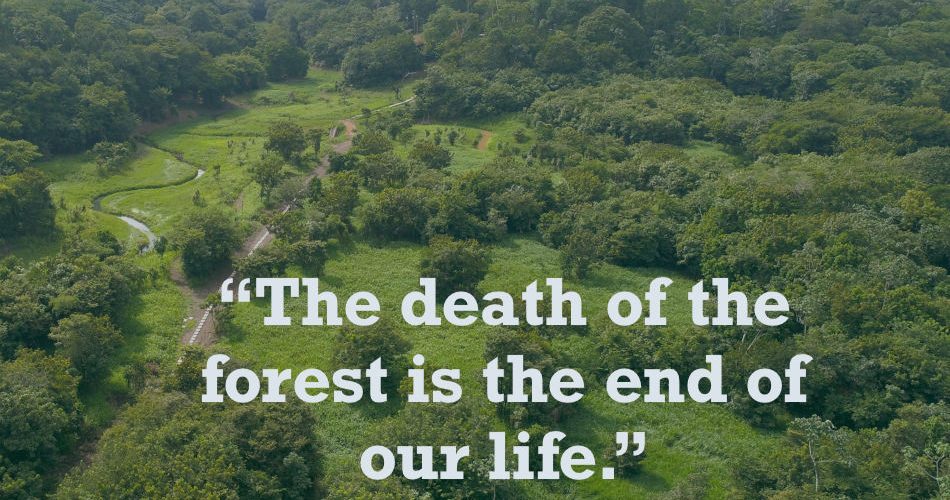(b.1931 – d.2005)
Part 1: Nonviolent activist and environmentalist
For more than 30 years, Sister Dorothy helped poor Brazilian homesteaders build independent lives through sustainable farming in the Amazon rainforest.
Sister Dorothy Stang was born July 7, 1931, in Dayton, Ohio. She grew up on a farm near Dayton with nine siblings during the Great Depression. She was raised in the Catholic Church. Sister Dorothy knew she wanted to devote her life to missionary work. She applied to the Sisters of Notre Dame de Namur. On her application she wrote, “I want to be a missionary in China.”
In 1948, Sister Dorothy joined the Sisters of Notre Dame de Namur as a candidate. Candidacy can last between 6 months and 2 years. During this time, a candidate receives education in ministry as well as areas best suited for her unique gifts or talents. These include healthcare, social services, education, and outreach to the poor. It wasn’t until 1956 that Sister Dorothy professed her final vows. These were vows of poverty, chastity, and obedience, but they allowed her to go freely out into the world to spread the teachings of the Catholic Church and interact with people.
Between her candidacy and final vows, Sister Dorothy taught elementary-school classes. She spent 14 years teaching in Phoenix, Arizona. Every Friday, she taught migrant workers and their children. Because Sister Dorothy grew up in a farming family during the Great Depression, she understood the challenges faced by the migrant workers.
In 1966, Sister Dorothy moved to the city of Coroatá in the state of Maranhao, Brazil. She and the other sisters began teaching the principles of Catholicism to the local population. They had to learn the language (Portuguese) and gain the trust of the locals, some of whom didn’t agree with the Catholic religion.
In 1970, Brazil opened the Trans-Amazonian region to homesteaders. Many poor Brazilians moved there to take advantage of the opportunity. Sister Dorothy followed them to the state of Para. She worked with the Pastoral Land Commission to teach homesteaders how to develop the land in a way that helped sustain the rainforest while making life easier for them. Slash-and-burn had been a standard farming method. Farmers cut down and burned rainforest vegetation to make room for planting crops. Land cleared in this way quickly lost its fertility. As a result, farmers had to move to another part of the rainforest and start over. Sister Dorothy understood the value of rainforests. Rainforests absorb carbon dioxide. This helps clean the air and reduce the effects of global climate change. When working with the homesteaders, Sister Dorothy often wore a t-shirt that read, “The death of the forest is the end of our life.”
Poor homesteaders weren’t the only people interested in the Trans-Amazonian region. Loggers, ranchers, greedy business owners, and politicians wanted the rainforest for themselves. They wanted to harvest lumber and raise cattle and cash crops such as soybeans. They moved into the area and began forcing poor farmers from their land. Hundreds of thousands of farm families lost their land and livelihood. As the mistreatment of the rainforest and the farmers continued, many local politicians turned a blind eye.
Part 2: Whose hunger for justice
Sister Dorothy spoke out against loggers and other people who intimidated homesteaders, occupied land illegally, and plundered the rainforest. Sister Dorothy opposed the thieves that destroyed both the rainforest and the lives of the people who lived there legally.
Sister Dorothy refused to allow the exploitation to continue. Her efforts to publicize and eliminate the plight of the farmers laid the groundwork for major policy changes. Conflict over land led to violence. Farmers who refused to leave their land were commonly killed. Many had their homes burned down. Sister Dorothy made it her duty to see that these violent acts did not go unnoticed by authorities. She helped the farmers rebuild, and she offered them hope. Although she had dreamed of working in China, Sister Dorothy had found her place, her people, and her mission: protecting Brazil’s poor farmers and the rainforest. The struggle and efforts of the farmers would always be close to her heart.
“I don’t want to flee, nor do I want to abandon the battle of these farmers who live without any protection in the forest,” Sister Dorothy said in a letter home. “They have the sacrosanct right to aspire to a better life on land where they can live and work with dignity while respecting the environment.”
Part 3: Helped bring change to Brazil
Threatened by her activism, a rancher hired gunmen to kill Sister Dorothy. After her death, Brazil’s president placed more than 9 million acres of the rainforest under federal protection.
As pressure from the loggers and ranchers increased, Sister Dorothy continued to appeal to the government for protection of the farmers. These requests were repeatedly denied, but her activism caught the attention of the loggers and ranchers. In the late 1990s, Sister Dorothy’s name was added to a death list with a bounty of $20,000. A mayor of a nearby town said that if there were to be any peace, Sister Dorothy would have to die.
In early February 2005, Sister Dorothy met with Brazil’s human rights officials. She spoke with this council about the dangers facing the farmers and the land. This was the last meeting she would have with government officials. On February 12, Sister Dorothy was on her way to meet with farmers to discuss their rights. She was walking down a dirt road when two men stopped her.
Sister Dorothy spoke with the men briefly and tried to move past them. They blocked her path. Then, from her Bible, she began to read, “Blessed are the poor in spirit….” The two men drew guns and shot Sister Dorothy before fleeing.
News of Sister Dorothy’s assassination spread quickly. More than 60 groups petitioned President Luiz Inácio da Silva to take a stand against the violence that had led to the illegal occupation of land.
In response, da Silva created two reserves. These reserves cover 9.3 million acres in the state of Para. Of these reserves, 22,000 acres were set aside for sustainable development by the farmers. Similar requests for reserves had been made before. Many people were upset that the government had been unwilling to act until Sister Dorothy’s death.
The president sent 2,000 soldiers to Para to keep the peace after Stang’s death. Eventually, five men were arrested and convicted in connection to the murder. This was a precedent for a region where loggers and ranchers often act with impunity. Of the 1,270 homicides between 1985 and 2013, fewer than 127 have been prosecuted.
The Catholic Church has recognized Sister Dorothy as a martyr and is considering her for sainthood. Her cause still lives on in Para. The local farmers know her story and tell it often. And efforts continue to combat deforestation and end exploitation of both the Amazon rainforest and its people.
“I am grateful to Notre Dame for not asking me to leave,” she once wrote. “This shows we are aware of the needs of the poor. The sisters have said they are worried about my safety. It is not my safety, but that of the people which matters.”
References
About Sister Dorothy (n.d.). In Sisters of Notre Dame de Namur. Retrieved from sndohio.org/sister-dorothy/
Allen Jr., J. L. (11 June 2015). “Martyred American nun could be the patron saint of the pope’s eco-encyclical.” In CRUX. Retrieved from cruxnow.com/church/2015/06/11/martyred-american-nun-could-be-the-patron-saint-of-the-popes-eco-encyclical/
Astor, M. (18 February 2005). “Brazil’s president creates massive forest reserves after killing of American nun.” In Environmental News Network. Retrieved from www.enn.com/top_stories/article/1005
Buncombe, A. (15 February 2015). “The life and brutal death of Sister Dorothy.” In universalrights.net. Retrieved from universalrights.net/heroes/display.php3?id=127
Ellerback, A. (12 February 2015). “Sister Dorothy Stang died fighting for Brazil’s landless; 10 years later, not much has changed.” In Religion News Service. Retrieved from religionnews.com/2015/02/12/sister-dorothy-stang-died-fighting-brazils-landless-10-years-later-not-much-changed/
Wallace, S. (January 2007). “Last of the Amazon.” In National Geographic Magazine online. Retrieved from ngm.nationalgeographic.com/print/2007/01/amazon-rain-forest/wallace-text
What is slash and burn farming? (n.d.). In Rain Forest Saver. Retrieved from rainforestsaver.org/what-slash-and-burn-farming


